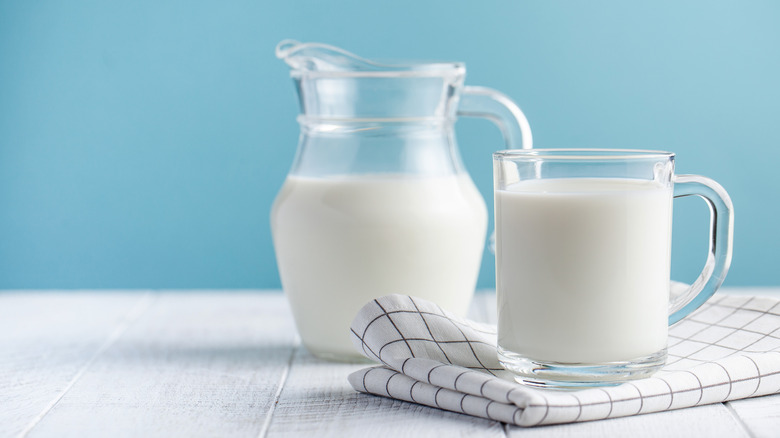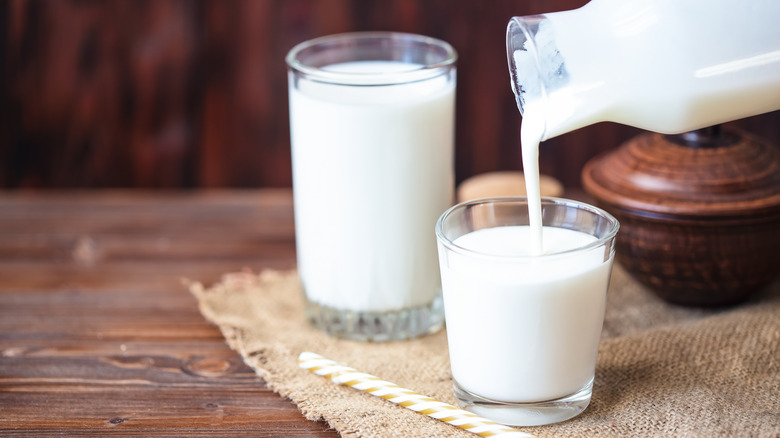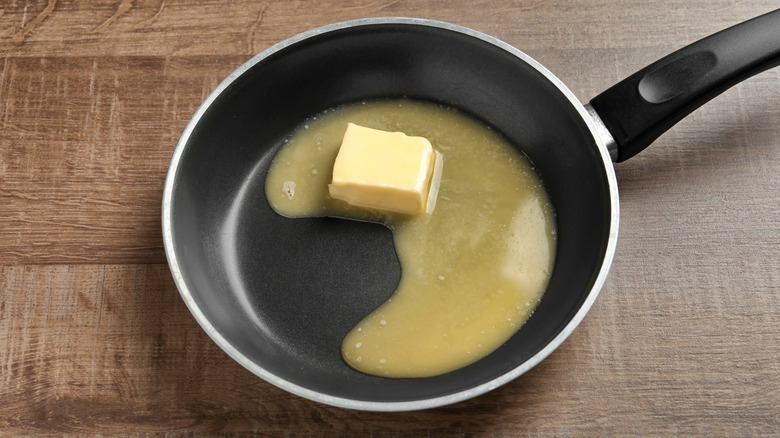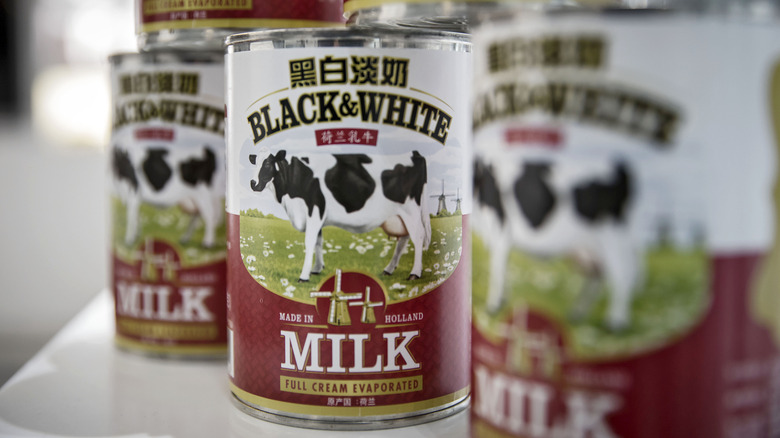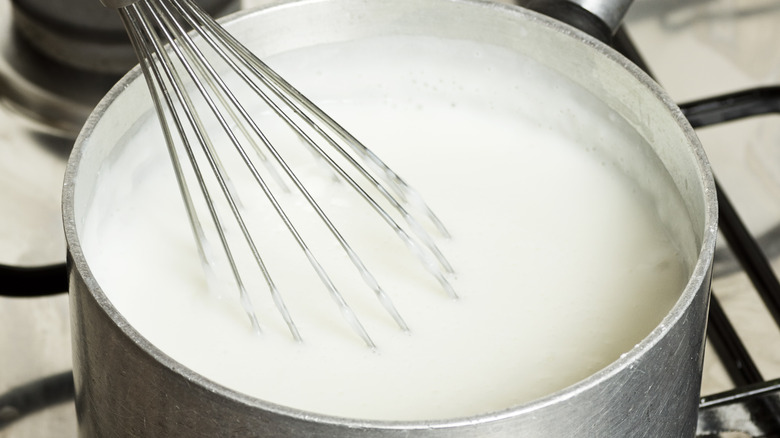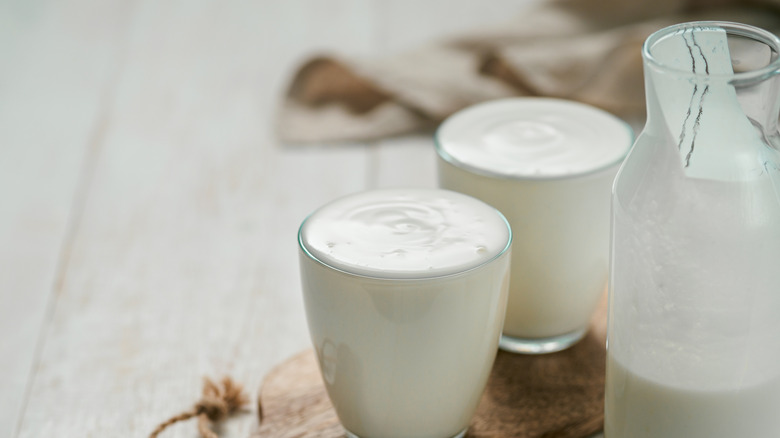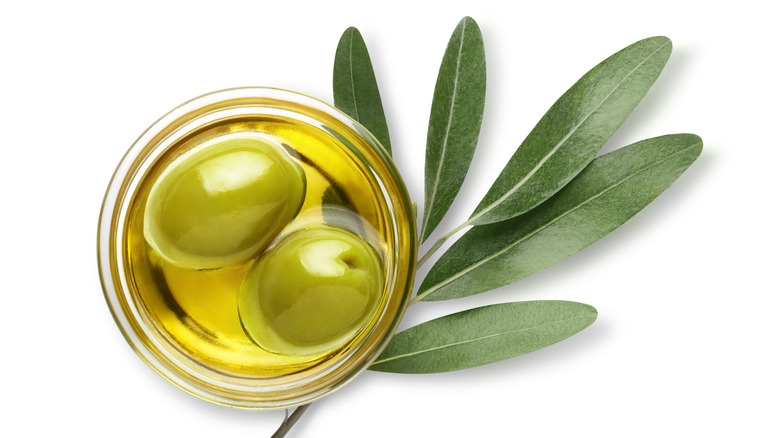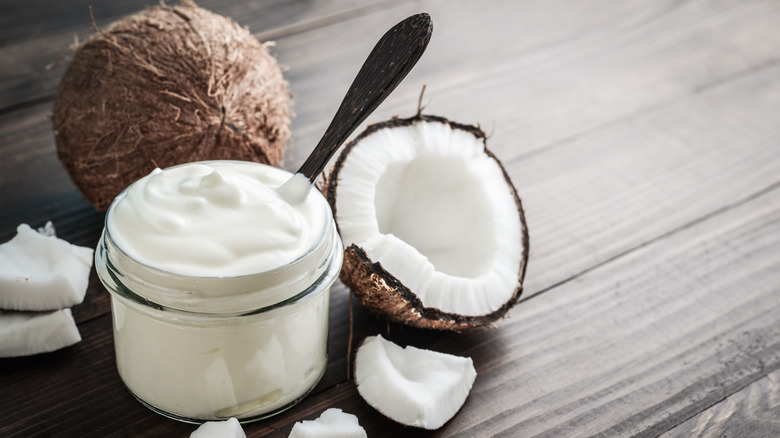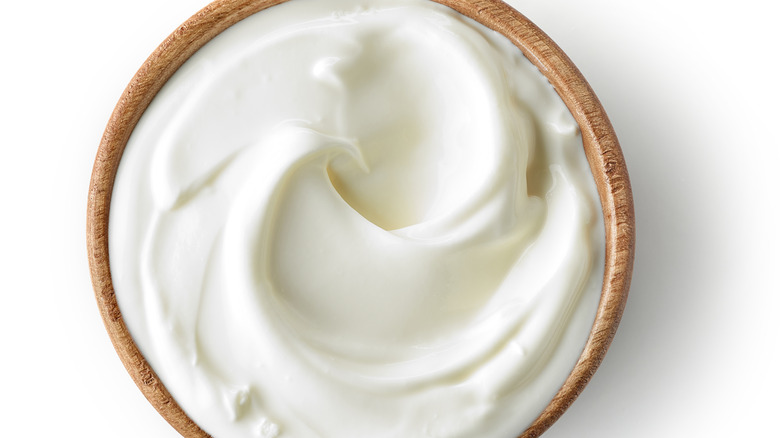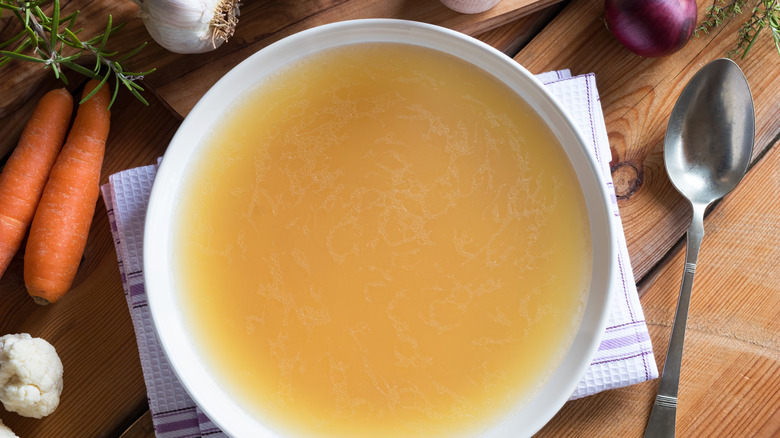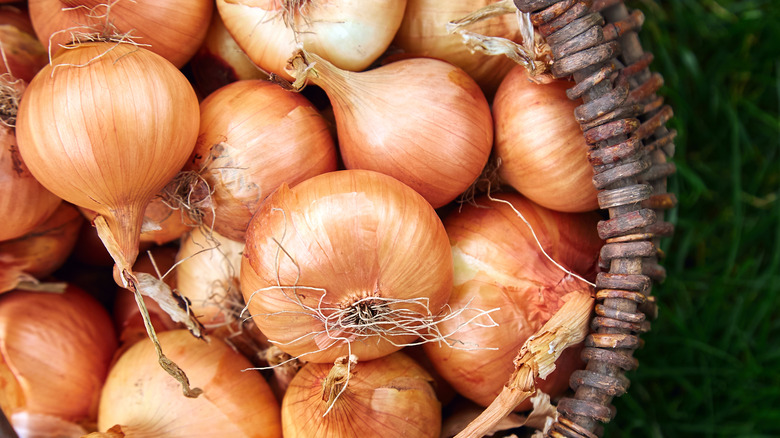10 Best Substitutes For Half-And-Half
We may receive a commission on purchases made from links.
If Google were to take a poll, we're guessing that the number two most searched question, after "what is half-and-half?" would probably be "what do I do if I don't have any half-and-half in my fridge?" It's not uncommon to see a carton of the creamy stuff in your office break room, or miniature, plastic canisters of it piled high on that little table in your favorite coffee shop, next to where they keep the lids and stirrers. But it's a bit less common in the typical household.
Half-and-half might be the thing your morning cup of joe is naked without, or the thing you've never used in your life and you're not sure why it exists. Either way, when someone asks for it and you don't have any, you're going to need a list of backups. That's where we come in. Get ready to separate the half-and-halfs from the half-and-half nots, and learn when to use which.
1. DIY half-and-half
Not quite cream and not quite milk, half-and-half is actually equal parts of both. Ipso facto, perhaps the most obvious solution to your half-and-half deficit is to DIY. Do you have heavy cream? Do you have milk? Then you have half-and-half, friend. Combine equal parts and shake well et voila; you don't even have to worry about accidentally churning butter because you shook too hard, because it's not just cream.
The half-and-half you buy in stores is usually homogenized, meaning machines blended the milk and cream together to make the finished product. Since you made your half-and-half the old-fashioned way, there is a chance the concoction will separate back out if you leave it in your fridge or add it to your coffee. To make sure the dairy doesn't curdle when you add to add it to something hot though, just make sure to temper it first (aka, add a little of the hot stuff and a little of your half-and-half to the same bowl, whisk, and then add that creation to the hot dish).
Since you're making your own half-and-half, use the same amount as you would store-bought.
2. Melted butter plus whole milk
Now we're talking. This is where it really feels like you're doing some science to replace your missing carton of half-and-half. Baking Mischief recommends slightly less than a cup of whole milk, combined with two teaspoons of melted butter (salted or unsalted, depending on how you're using it) for this particular half-and-half replacement, but take heed: it will definitely taste different. MyRecipes likes half a tablespoon of melted butter to an almost-cup of milk ratio (7/8 cup, to be specific), but says you can use margarine, too.
In terms of a baking substitute, the milk-and-butter mix will do the trick, but you might not want it for your coffee (lest you like a good, buttery, bulletproof coffee?) and, though you've essentially made cream, it's not going to whip the way heavy cream does.
If, after melting the butter and combining it with whole milk, you find that the result is not as thick as you'd like, Healthline recommends adding a tablespoon of flour to thicken the mixture.
3. Powdered heavy cream or evaporated milk
There's nothing worse than starting a complicated recipe, and realizing you're out of half-and-half (or milk, or cream, or any fresh dairy) just as you get to the step that calls for it. You're not going to run to the store while your dish bubbles away into burned, inedible bits, but unless you've got a cow on hand, it's not easy to make fresh milk appear from thin air. This is where pantry pals like powdered heavy cream and evaporated milk come in.
The Spruce Eats points out that powdered heavy cream is not widely available, but if you see it at a specialty shop or online, it might be a handy one to have in the cupboard. Reconstituting powdered cream means you can half-and-half in a jif, without the last-minute grocery run (or cow milking session). Evaporated milk is the same idea; the shelf-stable milk contains 60% less water than its refrigerated counterpart, according to Healthline, which means it will be thicker and creamier, like a certain half-and-half we know and love. If you're adding it to coffee or baking something sweet, why not be bold and add a cheeky drop or two of vanilla extract, too? You only live once, after all.
Recipes vary, but Anthony's Heavy Cream Powder recommends half of a cup of heavy cream powder combined with one cup of water for a half-and-half consistency (via Amazon). For evaporated milk, however, Healthline says the exchange ratio is 1:1. If your creation is too heavy cream-esque, thin it out with some milk.
4. Milk and cornstarch
Let's get back to the low-fat, low-calorie options in the world of things that taste kind of like half-and-half. Say you have milk, but you want something a bit thicker, creamier, or heavier, without resorting to a heavy cream or artificial creamer (tsk tsk, remember?) Try thickening the milk with cornstarch, suggests Healthline, which will mimic cream's texture without adding all those extra calories. Get even more calorie conscious by using skim milk instead of whole milk.
Healthline likes two tablespoons of cornstarch to every one cup of milk (whole or skim), to replace a cup of heavy cream, so maybe whisk in a little less if you are going for half-and-half texture. According to the New York Times, one tablespoon per cup of the liquid-of-your-choice is the magic (and easy-to-remember) recipe.
5. Milk and Greek yogurt
Another option if you do have milk on hand: mix it with some Greek yogurt. Anyone who has tried to cut through cold Greek yogurt with a flimsy, plastic spoon knows how thick that stuff is, and how chock-full of protein it is, too.
Mixing whole milk with Greek yogurt (equal parts of each) will give you something resembling heavy cream in consistency and texture; so, thinning it out a little by being heavy-handed with the milk will get you even closer to half-and-half. The flavor might not be as rich as the creamier stuff, but your protein count will be high and your fat count will be low, plus it will do the same thickening job for soups and sauces that half-and-half would.
6. Soy milk and olive oil
This one might sound a little strange, but in the world of vegan, dairy-free alternatives, there is much weirder stuff happening. Healthline claims "this substitute is best for adding tenderness and taste in cooking and baking," so in the words of Otis Redding, why not try a little tenderness? According to the New York Times, consistency is easily adjusted when you're working with liquids — just add a little water to thin something out, or a little flour/cornstarch to thicken it up.
Soy milk and olive oil are way too silky to whip, but pairing 2/3 cup of soy milk and 1/3 cup of olive oil will give you the equivalent of a cup of heavy cream, which you can then dilute a bit to give you that half-and-half consistency. Maybe don't put it in your coffee, though.
7. Coconut cream
While we're discussing dairy alternatives, let's talk coconuts. Coconut cream, which you can find — usually canned — in most grocery stores, is another thick, luscious shelf-stable staple you might want to reach for to replace half-and-half in your cooking or baking endeavors.
Good news if you accidentally bought coconut milk and you're feeling panicked right about now; don't fret! You're actually already halfway to coconut cream. Stick your full-fat coconut milk in the fridge overnight to separate out the liquid, says Healthline. Pour that liquid out, and the hard, thick stuff left in the can will be pure coconut cream. Cool, right? And again, if the coconut cream result is too creamy, then just ... try the coconut milk on its own, instead. We're not the boss of you.
You would "swap an equal amount of heavy cream for coconut cream and use it in recipes for your favorite sweets and baked goods," according to Healthline. If you find that's too creamy for your half-and-half needs, WebMD suggests thinning it out with soy milk, to keep your substitute dairy-free. (You can also thin it with a little water, which is always vegan.)
8. Crème fraîche or sour cream
Buckle up, buttercup; these options will take you to Flavortown, and they don't serve coffee on the flight. Or, rather, you shouldn't put these in your coffee, on your way to Flavortown. Forget it, let's just talk about lactic acid. Country Living explains that sour cream is just cream with lactic acid in it, which thickens it and adds a distinctly sour taste, hence "sour" cream. This means it is ideal for adding to a chili or sauce towards the end — to add texture and creaminess to your dish — but it might not be as tasty in your morning Americano. (Or, what do we know? Maybe sour cream lattes are the next big thing.)
Crème fraîche comes with a similar warning: the cultured cream is slightly tangy (and slightly fancy, check out all those accent marks), which means it will thicken your stew, soup or sauce, but not without bringing a sour note to the cooking symphony. Either option would be great in a dish that calls for half-and-half; just note that on the New York Times scale, creamy dairy products are at the firmer end of things.
There is no exact recipe for a replacement, but be sure to thin the crème fraîche or sour cream out with a little water to match half-and-half's consistency. If you're using either option for your baking needs, sweeten them with a bit of sugar or vanilla extract. And if you're just getting creative with coffee... well, take it easy, mkay?
9. Chicken stock
We can't tell you what to do, but please don't put this in your coffee, either. Chicken stock is an old standby when it comes to replacing heavy cream in a recipe, but no good can come from replacing the carton of half-and-half in the breakroom with a carton of chicken stock.
That said, Country Living likes chicken stock as an alternative to cream in "pan sauces, mashed potatoes, or pasta dishes," meaning if you were going to use half-and-half for any of those, try a little chicken stock, instead. Homemade chicken stock is even creamier, due to its viscosity, and the hearty umami of a good stock will take your dish to the next level without resorting to dairy.
While there is no perfect recipe for replacing your half-and-half with chicken stock, you can start with a 1:1 ratio and add stock to taste. As Taste of Home says about cream of chicken soup: "Substituting chicken broth would give you a similar flavor, but it could water down your soup or casserole." If you find that what you're making does become too diluted after replacing the half-and-half with chicken stock, the website recommends using cream of chicken itself, or making a quick roux to thicken the dish.
10. Onion cream
Food52 came up with this vegan hack, and we have to admit, it's pretty awesome. Roast some onions (sweet or regular), add a little vegetable oil, then salt, lemon juice, and olive oil to taste, and purée it all in a Vitamix or blender. Feel free to run the mixture through a fine-mesh strainer afterwards to get the smoothest, silkiest result, but the endgame is the same: a "glossy cream-like substance" that will add richness to soup, mashed potatoes, risotto, quiche... (almost) anywhere you might have half-and-half'd. Just don't come after us if your onion cream coffee isn't a bestseller.
As with chicken stock, replacing your half-and-half with onion cream is an art, not a science. Using the same amount of half-and-half as the recipe calls for will get you close to the desired consistency, but baker beware: this is not a substitution to try when you're making cupcakes, unless you're going for onion cakes. Like the New York Times says: "Flavor and texture are important considerations when substituting dairy products." So, if you're using half-and-half in a savory, earthy-flavored dish, start with a 1:1 recipe when adding in your onion cream and go from there until it tastes right. Otherwise, proceed with caution.
